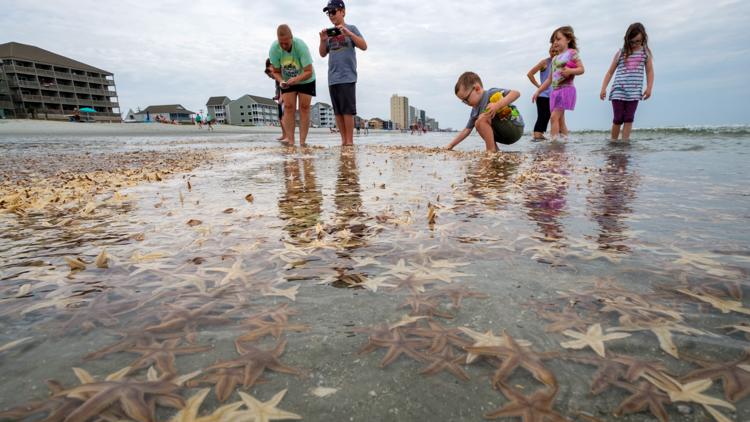HILTON HEAD ISLAND, S.C. — Large quantities of starfish have been seen scattered along Hilton Head Island beaches recently. Although it may look alarming, this is actually a natural event that’s fairly common in the Lowcountry.
Users, both locals, and tourists, took to Facebook shocked at their findings along the shores of Hilton Head Island beaches. One user reported finding up to 30 starfish on her morning beach walk and swiftly returned them to the ocean waters.
The numbers of starfish are on a smaller scale than the mass quantities of starfish that have become stranded in previous years. In 2018, over 1,000 starfish washed ashore on Lowcountry beaches, with Hilton Head Island included in those sightings. Roughly 100,000 starfish washed ashore on Fripp Island beaches in 2014.
Typically, in the winter or spring months when the temperatures are cooler in the Lowcountry these starfish, also known as sea stars, are more prone to large-scale strandings from being washed ashore. The reason behind this is that starfish are ectothermic or cold-blooded. This causes them and other small, ectothermic marine animals to lose most of their mobility until they can reach warmer temperatures. Thus, they are at the mercy of the tides. Contrarily, if sea stars reach too warm of temperatures, they will remove their own arms to protect against overheating. They can also do this to evade predators.
Temperatures near Hilton Head have recently seen lows in the upper 50s and low 60s.
Another possible reason they could be stranded is due to a phenomenon called ‘starballing.’ In this case, starfish curl their arms into a ball, allowing them access to faster modes of transportation via strong winds, currents, and tidal conditions. When this occurs, the sea stars can be seen rolling over the seafloor. Some even reach out an arm as if to test the currents.
If starfish are found washed ashore, one shouldn’t automatically assume they are dead.
While it’s sometimes hard to tell, in most cases, these starfish are still alive. Beachgoers who view them from a close distance might even see them slowly crawling along the shore or catch a glimpse of their tubular feet moving.
These tubular feet look almost like moving hairs underneath the arms of a starfish. These ‘feet,’ or small tubular projections, are what make sea stars echinoderms. Other echinoderms with tubular projections on their undersides include sea urchins, sand dollars, and sea cucumbers.
Even if these feet aren’t seen to be distinguishably moving, beachgoers should still throw them back into the water. They may just be moving slower than can be seen with the naked eye, meaning the sea star is alive and should be rescued when possible.
On Hilton Head Island, it’s illegal to disturb or take home any living beach organism, including starfish and sand dollars. Doing so could result in a $500 fine.
Municipal Code Title 8 Chapter 1 — “Beaches” describes the illegality of causing any physical harm, harassment, or disturbance of any marine fauna on Hilton Head Island.
For a complete list of prohibited beach activities, visit this Hilton Head Island website.



